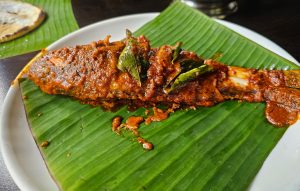In the vast and diverse landscape of India, where traditions are as varied as the languages spoken, the culinary realm stands as a testament to the country’s rich cultural tapestry. Food, in India, is not just sustenance; it is an expression of identity, a celebration of diversity, and a canvas on which the brushstrokes of countless traditions converge. As the world shrinks into a global village, the impact of cultural exchange on our Desi plates becomes a flavorful journey, transforming our kitchens into vibrant hubs of creativity and innovation.
As our world becomes increasingly connected, the influence of cultural exchange on our plates in the Indian context is nothing short of a flavorful journey. This blog aims to delve into the intricate relationship between cultural exchange and the vibrancy it imparts to our Desi gastronomic experiences.
Culinary Melting Pot:
In the bustling cities of India, the culinary landscape mirrors the cultural amalgamation that defines our nation. From the streets of Delhi to the beaches of Goa, one can savor the fusion of flavors that epitomizes the Indian culinary melting pot. Dishes like Indo-Chinese noodles and the South Indian pizza reflect the beautiful marriage of regional flavors with global influences, creating a uniquely Indian gastronomic experience.

Migration and Culinary Diasporas:
India, with its rich history of trade and migration, has been a melting pot long before globalization became a buzzword. The spread of Indian communities worldwide has given rise to a global Indian culinary diaspora. Think about the ubiquitous presence of biryani or samosas in various corners of the globe, a testament to the flavors that have transcended borders, making a home in the hearts (and stomachs) of people worldwide.
Globalization and Access to Ingredients:
As India becomes more connected to the world, our kitchens are evolving into global pantries. Ingredients that were once confined to specific regions are now finding their way onto our plates. From avocados to quinoa, our choices are no longer bound by geographical constraints. The global pantry has opened up new avenues for experimenting with international ingredients, enriching our traditional recipes with a touch of global flair.
Social Media and Culinary Trends:
In the age of social media, Indian kitchens are witnessing a revolution fueled by culinary enthusiasts, bloggers, and chefs. Platforms like Instagram and Facebook are buzzing with innovative recipes that draw inspiration from global cuisines. The viral popularity of dalgona coffee or the fusion of traditional Indian sweets with Western desserts showcases how cultural exchange, accelerated by social media, is transforming our daily culinary experiences.
Celebrating Diversity through Festivals and Events:
India, with its myriad festivals and diverse cultural celebrations, provides ample opportunities to showcase and appreciate different culinary traditions. Food festivals that feature regional specialties, traditional sweets, and street food from across the country have become popular. These events not only celebrate the diversity of Indian cuisine but also inspire individuals to incorporate flavors from different regions into their daily meals.
Culinary Tourism:
The concept of culinary tourism is not new to India. Travelers crisscross the country, seeking authentic regional dishes that tell the story of India’s cultural tapestry. From the chaat stalls of Delhi to the seafood delights of Kerala, culinary tourism in India is a journey through the kitchens of diverse communities, each contributing its unique flavors to the Indian culinary narrative.

Health and Wellness Trends:
Traditional Indian practices have long emphasized the connection between food and well-being. In recent times, global wellness trends have found resonance in India, influencing our food choices. Ayurvedic principles, for instance, are gaining popularity not only within the country but also internationally. As Indians embrace wellness trends from different cultures, our plates reflect a harmonious blend of traditional wisdom and global health consciousness.
Challenges and Appropriation:
Amidst the celebration of diverse flavors, it is essential to navigate the fine line between appreciation and appropriation. One of the challenges arises when traditional Indian dishes are misrepresented or oversimplified. This can occur when global adaptations lose the essence and authenticity of the original recipes. For instance, the Westernized versions of popular Indian dishes, often found in international fast-food chains, might lack the depth of flavor and cultural significance inherent in traditional preparations. The commercialization of Indian cuisine on a global scale brings both opportunities and challenges. While the popularity of Indian dishes worldwide is a testament to their appeal, it also raises concerns about the commodification of cultural heritage. The line between sharing the richness of Desi cuisine and exploiting it for commercial gain can be thin, demanding a delicate balance.
While global chefs and food enthusiasts are increasingly drawn to Indian ingredients and cooking methods, it is essential to approach these traditions with respect. Understanding the historical, religious, and cultural significance of ingredients and recipes helps avoid unintended appropriation and promotes a more authentic representation of Desi cuisine on the global stage. The global popularity of Indian dishes has led to instances of misrepresentation and cultural appropriation. Sensitivity and understanding are crucial as we share our culinary treasures with the world, ensuring that each dish retains its cultural significance and is presented with the respect it deserves.
In a nation as diverse as India, our food choices are a celebration of the rich cultural tapestry that binds us together. From the fusion of flavors in our bustling cities to the global spread of traditional dishes through migration and technology, our culinary landscape is evolving, embracing the global while staying rooted in our Desi traditions. As we continue to explore, share, and relish the diverse flavors that make up our culinary mosaic, we contribute to a cultural exchange that celebrates unity in diversity. The culinary journey across India is a symphony of spices, a dance of flavors that transcends borders and brings people together in the joyous celebration of good food. The culinary mosaic, painted with the hues of cultural exchange, is a testament to the fact that, in our shared love for food, we find a delicious unity in diversity.
